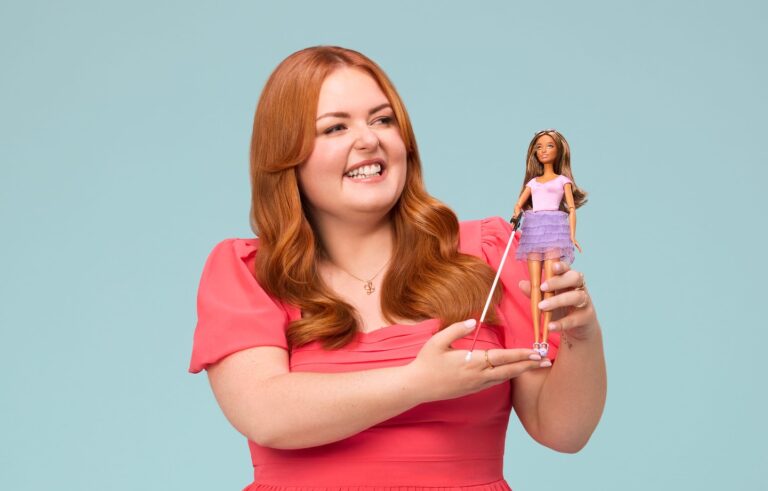Toy maker Mattel on Tuesday launched its first blind Barbie in partnership with the American Foundation for the Blind, an advocacy group for the blind and low vision. Everything from Barbie’s outfit to her packaging was designed to help children who are blind or low vision find a doll that represents them, Mattel said in a news release.
Lucy Edwards, a disability activist and British TV announcer who lost her sight at age 17, is taking part in Mattel’s campaign to launch their latest doll. “When I see blind Barbie, I feel validated,” she said in a video shared by Mattel in which she was filmed holding the doll for the first time.
She said she used to be embarrassed to hold a cane when she was younger, but she likes how Barbie’s cane fits snugly in her hand and the texture of the ruffled skirt. “I’m really impressed. I wish I’d had this when I was little.”
Mattel said the tactile fabrics of the doll’s pink satin T-shirt and purple tulle skirt were chosen after testing the doll with children who are visually impaired. In that statement. The company said the doll has sculpted elbow joints to allow Barbie to move comfortably around her wand, an elasticated waistband on her skirt for easy dress-up play, and the box the doll comes in has “Barbie” written in Braille.
Mattel also consulted with the Royal National Institute for Blind People when developing the doll.
“It’s fantastic that children who are visually impaired will now be able to play with a Barbie doll that looks just like them,” RNIB spokesperson Debbie Miller said in a news release issued by Mattel. “This means a lot to the blind and low vision community as it acknowledges that not everyone can see well. It’s a positive step.”
Parents of children with disabilities have spoken out about how difficult it is to find a doll that represents them.
In its guide to finding toys for children with visual impairments, the RNIB says toys that have clear contrast in colour and tone, bold lettering, good light reflections and interesting textures, smells and sounds are particularly suitable.
“All children love to play, and vision is just one way of exploring and learning about the world,” the guide says, adding: “Toys with glasses, guide dogs or white canes help visually impaired children develop positive self-esteem and express their experiences through role-play. These toys also help them explain diversity and difference to siblings and sighted friends.”
The blind Barbie was released at the same time as the first black doll with Down syndrome. Mattel will release a white doll with Down syndrome in 2023.
Krista Berger, senior vice president and head of global dolls for Barbie, said the doll demonstrates Mattel’s “commitment to creating products that represent a global sense of belonging and inclusivity in the doll aisle.”
Both new dolls are part of Barbie’s “Fashionistas” series, which was introduced in 2009 and now includes more than 175 dolls with a variety of body types and skin tones. The series also includes dolls with vitiligo, dolls with hearing aids, dolls without hair, dolls with prosthetic legs and dolls in wheelchairs with ramps.
For decades, Barbie has been criticized for lacking diversity and promoting unrealistic beauty standards, but Samir Hosani, a marketing professor at Royal Holloway University in London, previously told The Post that Mattel has been “sensitive and adaptive to changing cultural and political discourse in society” and has continually updated the doll, such as through its “Fashionista” series, which has led to the doll’s long-term success.


